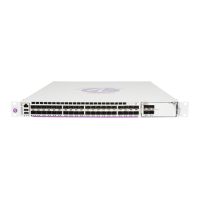IP Router Configuration
7705 SAR OS Router Configuration Guide 119
The command returns an error if the interface is already associated with another port or the system. In
this case, the association must be deleted before the command is reattempted.
The port name consists of the port-id (for T1/E1 interfaces and Ethernet interfaces) and an optional
encapsulation value (for Ethernet interfaces). The port name can also be the bundle-id used for the
multilink bundle (PPP or IMA). Refer to the 7705 SAR OS Interface Configuration Guide for
information on configuring ports.
The no form of the command deletes the association with the port. The no form of this command can
only be performed when the interface is administratively down.
Default no port
Parameters port-name — the physical port identifier, in the form port-id[:encap-val]
Values encap-val 0 (for null)
0 to 4094 (for dot1q)
port-id — the physical port identifier
Values slot/mda/port[.channel]
bundle-id bundle-type-slot/mda.bundle-num
bundle keyword
type ima, ppp
bundle-num 1 to 32
aps-id aps-group-id[.channel]
aps keyword
group-id 1 to 24
mw-link-id mw-link-link-num
link-num 1 to 24
proxy-arp-policy
Syntax proxy-arp-policy policy-name [policy-name...(up to 5 max)]
no proxy-arp-policy
Context config>router>interface
Description This command enables proxy ARP on the interface and specifies an existing policy statement that
controls the flow of routing information by analyzing match and action criteria. The policy statement
is configured in the config>router>policy-options context (see Route Policy Options in the Route
Policy Command Reference section). When proxy ARP is enabled, the 7705 SAR responds to ARP
requests on behalf of another device.
Default no proxy-arp-policy

